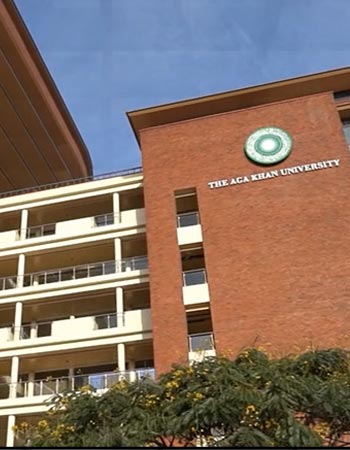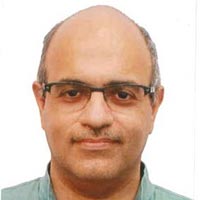AKU's first green building certification - Anosh Elavia
 Anosh Elavia is the Projects Director for AKU in East Africa. The University Centre Nairobi (UCN) building received EDGE Advanced certification under his leadership and guidance. In this interview, we discuss the process of and learnings from this green building certification and his personal motivations to work for the cause.
Anosh Elavia is the Projects Director for AKU in East Africa. The University Centre Nairobi (UCN) building received EDGE Advanced certification under his leadership and guidance. In this interview, we discuss the process of and learnings from this green building certification and his personal motivations to work for the cause.
Can you provide a little background on yourself?
I'm a civil engineer by profession and used to be partner in a construction firm. Before joining AKU in Nairobi, I worked with various AKDN agencies in different countries.
What was the process for obtaining the EDGE Advanced certification?
The UCN building was, in 2013, originally designed for the Faculty of Health and Sciences and the Doctor's Plaza. However, in 2017, when a building was required to comply with AKU’s Charter in Kenya, it was redesigned as the University Center. During all this time, EDGE was not a consideration as the AKDN Green Building Guidelines came in late 2020, when the building was almost completed.
After the building was constructed, we found that it met many of the EDGE Advanced requirements. For me it is a matter of immense pride that our internal sustainability standards were already high enough to achieve EDGE Advanced certification even post construction.
What are some of your favorite design or sustainability features of the UCN building?
This building was designed to be naturally ventilated at all times. In an urban setting, we have incorporated many landscaping features such as open terraces and planters on the 2nd floor and lush landscaping in front and back of the building to shield it from the busy access road.
The building is a joy to work in for me because there is always natural ventilation with air and light passing through the offices and corridors.
As engineers and contractors, we know that around 80% of the building life cycle cost is the operational cost. Therefore, incorporating measures which reduce operational costs and consumption of resources such as water and energy is a priority. For example, air conditioning only those spaces which you cannot naturally ventilate, reducing water consumption by installing low-flow fixtures and two-flush systems in toilets, using solar power for water heating.
What were some of the challenges and learnings by your team in obtaining the EDGE Advanced certification?
The process was not quite simple and straightforward. The whole certification process took much longer than we had originally anticipated. One major challenge was working with EDGE auditors and meeting their information and calculation requirements. Moreover, there were certain features such as open corridors for ventilation which EDGE did not consider while giving points. So, we had to request for exceptions.
One of our learnings has been that we need to incorporate all stakeholders, including the end users and all consultants on our certification requirements from the very beginning. It makes sense to have the design audited before you start construction rather than doing it later, as we did. And it's important to form a relationship with the auditors so that expectations are understood and met.
What has been your biggest achievement on sustainability so far?
I think I'm generally proud of the fact that sustainability measures have now become standard operating procedures for whatever projects we design. And this is the way to go.
We are trying to see how we can continue to reduce our energy consumption and have internally set the target of making UCN a net zero building in the next few years.
How do you build team morale and ownership around the sustainability agenda?
If you want people to take you seriously, simply practice what you preach. It starts with leading by example. That’s when they realize its benefits and adopt sustainable practices.
Tell us about some of the innovations you're bringing into your current or future work regarding sustainability.
I believe in continuing to learn. I keep reading about EDGE and other sustainability standards as well as work done by other agencies because we can continue to make incremental sustainable improvements to our designs to save resources and cost. For example, we are now adding occupancy sensors on different floors in the UCN building to further reduce energy consumption.
The Living Buildings Challenge focuses on adding positives to the construction process in addition to eliminating the negatives. There are very few Living Buildings constructed in the world (mostly in North America) but learning from them and incorporating some of the features is interesting and something I'm trying to do next.
What personally motivates or inspires you to continue this work?
I'm motivated by my kids because I want to leave behind a livable planet for them.
On people who inspire me: I must admit that's my wife. She makes sure we switch off everything when we leave the room. We recycle everything – every piece of paper is recycled, and all our wet waste goes in a vermicompost pit. If we can do that at home, then why not in our buildings? That is my main inspiration, and I keep pushing the envelope bit by bit.
What makes you hopeful about the future of sustainability at AKU and our role in promoting this agenda publicly?
I think we are seeing a sea change now even within AKU in terms of sustainability. It is no longer a buzzword people throw around. We have started practicing it, for example, we have no more plastic bottles on campus. I'm hopeful that soon living sustainably will become a part of our daily lives.
Talking about sustainability is not enough – the best way to demonstrate to people is by implementing these concepts ourselves.

Anosh Elavia

